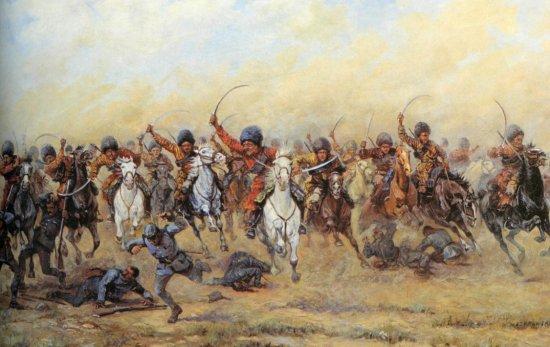The national holiday of the Republic of Bulgaria on March 3 (national holiday since 1990). On March 3 [February 19, old style], 1878 was signed the San Stefano Peace Treaty between Russia and the Ottoman Empire, which ended the Russo-Turkish War of 1877-1878 (tenth in a series of Russo-Turkish wars), which was called by the Bulgarians “Liberation war”, as it led to the liberation of Bulgarians from the Ottoman Empire and the creation of the Third Bulgarian kingdom. On the eve of the Bulgarian national holiday we open a forgotten page in the history of the Liberation of Bulgaria in the 19th century, related to the participation of Muslims from the Caucasus in the Russian army in liberating the fraternal Orthodox Bulgarian people from sultan’s oppression.
During the years of the Russo-Turkish War of Liberation from 1877-1878, the Russian army was mainly recruited from South Russia to the North Caucasus (South Caucasus is in Ottoman Turkey), including Cossacks (Don and Cuban), Chuvash, Ingush , Chechens, Kumits, even Circassians. The formation of the Tersko-Mountain Cavalry Regiment was successfully completed by November 25, 1876. During the formation of the regiment, the military leadership set itself the task of giving it the external attributes of a regular cavalry. A uniform form of clothing has been introduced for all staff. Circassian uniforms are supposed to be black, without trimmings, white beshmets, black tops with white tops, with soft Asian boots, and the epaulets are blue, with the letters T-G.
The regiment was created by the population of the Terek region in the Caucasus and consists mainly of Ingush and Ossetians, but there are also Russians, Georgians and Chechens. Two divisions were created for the regiment – Ossetian and Ingush, and each of them was exceptionally allowed to march with his own flag. On December 1, the individual flags of the divisions were awarded in a solemn atmosphere: for loyalty and devotion to Russia to the Ingush people in 1841, and to the Ossetian – in 1845. Interestingly, the Ingush flag was completely scarlet and very similar. today’s Turkish, while Ossetian is sky blue. Each flag is raised in line with all the honors awarded to the flags and standards of the army statute. In addition, each hundred has its own distinctive sign that serves as its flag.
On December 7, 1876, the Terek-Mountain Cavalry Irregular Regiment, consisting of troops “especially capable of the actions of the small war in mountainous countries”, set off on the Rostov-Vladikavkaz railway to Chisinau, where the headquarters of the Danube army, and arrives there on December 15. In addition to this regiment, the Cuban and Terek squadrons, the Vladikavkaz Cavalry Cossack Regiment, two hundred platoon members of the Kuban Cossack Army and the 2nd Kuban Cossack Regiment set out in the convoy of His Majesty from the Tersk and Kuban regions in the Danube Army.
On May 24, 1877, the Commander-in-Chief of the Caucasian Army ordered the commander of the troops from the Terek region to proceed with the formation of the 2nd Terek-Mountain Cavalry Irregular Regiment with a 400-strong composition: one hundred Kabardians, Balkars, Ossetians and Ingush. Adjutant Colonel Wittgenstein was appointed regiment commander. At the same time he was the commander of the Terek cavalry and irregular brigade, consisting of the Chechen and Kabardino-Kumik cavalry irregular regiments.
The composition of the Chechen regiment is also international. In it, along with the Chechens, the Russians Flor Ekimov, Vasily Frolov, Ivan Antipov, Trofim Kurkin also serve; the Germans Karl Taichmann, Wolf Dorfstein; Ingush Asav Kuriev, Tokh Bekov, Tomi Doltmurziev and others, Ossetians – Zaur Thostov, Peter Khutsistov, mountain Jews – Shamil Uruskhanov, Uruskhan Shamayev. Thus, in addition to the Don Cossacks, the Terek Cossacks took an active part in the Russo-Turkish War of the 1970s in the following Cossack troops:
Combined Caucasian Cossack Division
Cuban 2nd Regiment
Don-Cossack 30th Regiment
Vladikavkaz-Ossetian Cossack Regiment
Tersko-upper-mountain cavalry and regular regiment
Don-Cossack 1st cavalry battery
1st Don-Cossack Division
Don-Cossack 15th Regiment
Don-Cossack 16th Regiment
Don-Cossack 17th Regiment
Don-Cossack 18th Regiment
11th, 16th and 17th Horse Battery
2nd Don-Cossack Division
Don-Cossack 24th Regiment
Don-Cossack 36th Regiment
Don-Cossack 38th Regiment
Don-Cossack 39th Regiment
Don-Cossack 1st cavalry battery
Don-Cossack 21st, 23rd, 26th, 29th, 31st, 34th, 35th, 37th, 40th regiments
Leib Guards Ataman Regiment
Leib Guards Don-Cossack Regiment
Ural-Caucasian hundred
7th Plastun Division of the Cuban Army
3rd Gendarmerie Squadron
Don-Cossack battery 7th, 8th, 10th, 15th, 18th, 22nd, 23rd, 24th
Mountain battery 1st and 2nd
Siege artillery
Rapid-fire battery
As early as 1810, a treaty was signed in the Vladikavkaz fortress for the voluntary accession of Ingushetia to Russia. The significance of this event for the historical destiny of the Ingush people is difficult to assess. Becoming part of Russia forever saves the mountaineers from the age-old threat of their physical destruction by Shah’s Persia and the Ottoman Empire. Russia, standing at a much higher level of socio-economic and cultural development, has a beneficial effect on the whole way of life of the Ingush. The Russian government and its Caucasian administration attach great importance in their plans to combat the expansion of the Ottoman Empire and Shah’s Iran in the Caucasus to the organization of military units with representatives of the mountain peoples and their attraction to their country. In the 1980s, the tsarist government for the protection of the Caucasus began to create military detachments of mountaineers.
When the Russo-Turkish War of 1828-1829 began, General Paskevich, Commander-in-Chief of the Caucasus Army, wrote: . ” In this war, along with the militia from the Caucasus, with the mountaineers from Dagestan, the Chechen cavalry led by Bey-Bulat Taimiev also took part. At the beginning of this war, Paskevich summoned Bey-Bulat with 60 Chechens to Tiflis (Tbilisi). From Tiflis in the active army 33 people go to them. Chechen cavalry take part in the march of Russian troops to Erzurum (Arzrum).
The Ingush, like other peoples of the Caucasus, took part in the Crimean War of 1853-1856. Together with Azerbaijanis, Armenians, Georgians, Chechens, Dagestanis, Kabardians and Ossetians, they actively fought against the Turks in the Caucasus. front. Among those awarded a memorable bronze medal at the end of the war were 325 Ingush, regular cavalry and 80 temporary militia officers who took part in the fighting “against the rebellious mountaineers and against the Turks at the Caucasus Battle Theater …”.
The fighting in the Russo-Turkish War of 1877-1878, as well as during the previous wars between Russia and the Ottoman Empire in the XIX century, unfolded on two fronts – the Balkans and the Caucasus (Asia Minor). Irregular (militia) units formed by representatives of the peoples of the North Caucasus are also fighting on these two fronts in the Russian army. From the first to the last day of the war, the Tersko-Mountain Cavalry Irregular Regiment, consisting of 400 Ossetians and Ingush, took part in the Balkan Front. On the Caucasian front, the 2nd and 3rd Dagestan, Chechen, Kabardino-Kumik cavalry and irregular regiments, numbering 600 sabers, took part in the fighting.
In the Terek region, “almost the entire population expressed a desire to join the militia.” In the first days of the call, volunteers were recruited more than necessary to create a regiment. 345 Ossetians and 324 Ingush expressed a desire to join the regiment in the first week of its formation. All in all, 504 people need to be recruited (480 horsemen, 8 cadets, 16 curators). According to the established temporary marching staff, it consists of 15 officers, 8 cadets, 16 curators, 480 horsemen, 5 trumpeters, 4 clerks, 1 doctor, 2 paramedics, and 1 Asian baker. The commander of the Vladikavkaz district, Colonel PF Ponkratov, was appointed commander of the Tersko-Mountain Regiment, cornet adjutant – cornet Zheleznyakov, and regimental cashier and quartermaster – cornet Kosobryukhov. Instead of the previously expected Staff Captain Bekmurzy Kubatiev, Captain Arslan-Murza Esiev became Commander of the Ossetian Division, and Lieutenant Colonel Banukho Bazorkin was entrusted with the command of the Ingush Division. Cornet Agu-Bekir Dudarov and Lieutenant Totradze Zembatov were appointed commanders of the Ossetian hundreds, and Lieutenant Botako Uzhahov and Major Banuho Dolgiev were appointed commanders of the Ingush hundreds.
The following were enlisted as subaltern officers (junior officers) in the regiment: in the 1st (Ossetian) division – ensigns (flag bearers) Miserbi Gutiev, Gidanov, Dzhambulat Cherekov, Getagas Thostov, Alexander Dzugaev, Genarduko Abisalov and Temu (Ingush) Division – Lieutenant Magi Nauruzov, Ensigns Doh Malsagov, Kerim Bogatyrev, Artagan Malsagov, Captain Nikolai Aldiev, Lieutenant Genarduko Esenov, Lieutenants Umar Sampiev and Gani Dzhemiev.
On September 24, 1877, the Ingush division was sent to the XIII Army Corps by the Active Army, which is part of the Eastern (Ruse) detachment. He was attached to the eighth cavalry division of the Sinankoi Corps Detachment. On October 12, together with the Cossacks of the 36th Don Regiment, he took part in repelling a Turkish attack near the villages of Nisovo, Ruse region and in reconnaissance battles behind the Beli Lom River. On October 18, he carried out a reconnaissance in the area of the villages of Svalenik, Ljubljana and Sadina. In early November, Turkish troops intensified their activities in the Cherni Lom area. The Ingush division took part in the battles near the village of Katselovo and showed exceptional courage. From November 12 to 17, the division fought in the area of Tserovets and Katselovo in aid of the Life Guards Ataman Cossack Regiment. front line and conduct reconnaissance.
However, many Caucasians are also fighting on the opposing side – both in the Caucasus itself and in the Caucasian diaspora. According to the Cuban historian ED Felitsin, 13,586 people emigrated from Kuban to Turkey from 1871 to 1883, including 11,417 Adyghe and 1,809 Abaza. In 1878, the most numerous were Abkhazian volunteers in the Ottoman army. . The Russo-Turkish war closed the door to their homeland forever through these emigrants from the Caucasus. A total of nearly 50,000 Abkhazians have been deported or emigrated due to collaboration with Turkish authorities. This vast expat community actively assisted the Hashemite dynasty in establishing the Hashemite Kingdom of Jordan.
The researcher from the Adygea Republican Institute for Humanitarian Studies Samir Hopko gives us a reference to the Russian headquarters for the Caucasian cavalry in the ranks of the Ottoman army of the Balkan Battle Theater: in Western Bulgaria – 9250 swords, in Eastern Bulgaria – 5000 swords, in the area of Babadag – 1800 sabi. In his diary, General PD Zotov described in the division of Hassan Sabli Pasha – 800 Caucasians, in the division of Shefnet Pasha – 1000 Caucasians, in the division of Zefi Pasha – 2200 fighters of Caucasian nationalities. In general, the Caucasian cavalry far outnumbers the regular Turkish cavalry. For example, in October 1877 in the region of Pleven-Lovech operated 5,000 Caucasian cavalry and 40 squadrons of cavalry from the regular Turkish army (against 118 squadrons of Russian cavalry). There are also Caucasians among the senior officers in the Ottoman headquarters: Rauf Pasha, Deli Khosrev Pasha, Cherkez Hassan, Cherkez Osman Pasha, Shefket Pasha, Cherkez Ibrahim Pasha, Dilaver Karzeg Pasha, Cherkez Dilaver Pasha, Fuad Pasha, Suleiman Pasha, Mehme Pasha . According to Skobelev’s report, Osman Pasha’s army in Pleven numbered 28,000, of which 20,000 were regular infantry and 8,000 Caucasian cavalry (cf. Collection of Materials on the Russo-Turkish War of 1877-1878, on the Balkan Peninsula, St. Petersburg, 1898, no. II, pp. 268).
According to Nemirovich-Danchenko, there are 1,000 Caucasian volunteers at the headquarters of Suleiman Pasha’s army. In Russian military reports, we find that Caucasians are much better armed than Turks and Russians. In the battle of Shipka, they were described as magnificent snipers. The Cossack colonel Dukmasov, Skobelev’s adjutant, pays special attention to the tactical maneuvers of the Caucasians in his memoirs. He was particularly impressed by the attack of two regiments of the Sultan’s Guard. We also find extensive information about the Caucasians in the letters of Count NP Ignatiev, a former Russian ambassador to Istanbul who was at the imperial headquarters during the war.
After the appointment of General Dondukov-Korsakov as Imperial Russian Commissioner in Bulgaria, the division was handed over to him. On May 24, the Ingush Division left the XIII Army Corps. Until August 28, 1878, the division held positions in the Rhodopes, after which it was included in the Burgas detachment. On October 5 he was loaded on ships and two days later arrived in Sevastopol. He left for Vladikavkaz, where he was disbanded on November 23, 1878.
Adjutant General Dondukov-Korsakov praised Ingush’s participation in the Russo-Turkish War. On September 2, 1878, he issued a special order in Plovdiv thanking the Tersko-Mountain Cavalry Regiment.
After the end of the work of the Berlin Congress (June-July 1878) it was decided to reduce the number of Russian troops temporarily stationed in Bulgaria. Among them is the Tersko-Mountain Regiment, which on August 28 was removed from a position in the Rhodope Mountains and included in the Burgas detachment. On October 5 the regiment was loaded on steamers in Burgas and two days later arrived in Sevastopol, after which they were warmly welcomed in Vladikavkaz, on October 23, 1878 it was disbanded and its cavalry dispersed to their homes.
Blown in glory, the Tersko-Mountain Cavalry Irregular Regiment returns to its homeland. The chests of many of the warriors are decorated with orders and medals, with St. George’s crosses for bravery. Many awards and thanks were received by the regimental commander Colonel PF Pankratov. The military leadership for bravery and composure in battle repeatedly distinguished him among other unit commanders, he was entrusted with the command of the united flying detachments, participants in the front line. The documents of the regimental headquarters preserved in the archives testify that PF Pankratov was a just and caring commander. Even in the conditions of the poorly organized quartermaster service of the active Danube Army, he finds the means and opportunities to ensure that his horsemen are warmly dressed and shod, emphasizing that this is the “first condition for health”.
In the above ranks are produced: the participant in the Crimean War, distinguished in the storming of the Turkish fortress of Silistra, Ensign Timurko Borov; Lieutenant Batako Uzhakhov. With the Order of St. Vladimir, 4th degree was awarded Captain Nikolai Aldiev. During the founding of the Ingush Division in the Lower Danube Detachment, he was the military commander of the city of Izmail, and from January 1878 he served as a division commander. On the eve of the recall of the Tersko-Mountain Regiment in the homeland, Captain Aldiev, by order of the headquarters of the active army, was sent to the Don Cossack Regiment №4 and continued his service in southern Bulgaria. Adjutant General Adjutant General AM Dondukov-Korsakov gave an excellent assessment of the Tersko-Mountain Regiment. In his order, issued on September 2, 1878 in the city of Philippopolis (Plovdiv), he said the following:
“In parting with you, brave horsemen of the Tersko-Gorski cavalry-irregular regiment, I consider it my heartfelt duty to express my sincere gratitude to you for your worthy service. The Ingush division was under the command of the XIII Corps for most of the past campaign under my command, and all the time he served in the front in the detachments and in all his deeds with examples of self-sacrifice, courage and all military valor. glory and respect from all your colleagues. The awards and flag received by the Ingush Division will testify upon returning home, how much is appreciated … the worthy service of the Ingush in the last campaign; your elders and your relatives will welcome you with pride when you return to the villages, having fulfilled their duty with dignity and proved the eternal devotion of the Ingush people to the Fatherland. For my part, I am happy and I will proudly remember that under my leadership there were such exemplary young men as the glorious Ingush Division. I consider it the most pleasant duty to pay a well-deserved tribute and the most sincere gratitude to the glorious regimental commander Colonel Pankratov, so brilliantly fulfilling all the orders given to him during the war, who was one of my most active combat collaborators in my command. of the XIII Corps. To the division commanders Major Esiev and to Captain Aldiev, to the commanders of hundreds, Ensign Thostov, Lieutenant Zembatov, Lieutenant Uzhahov and Ensign Malsagov, I express my sincere and warm gratitude for the valiant and diligent service. To my brave colleagues – all the ranks of the Tersko-Mountain Cavalry Irregular Regiment, for which I will forever cherish the most precious memory – with all my heart I wish you new glory, happiness and all the best. “












